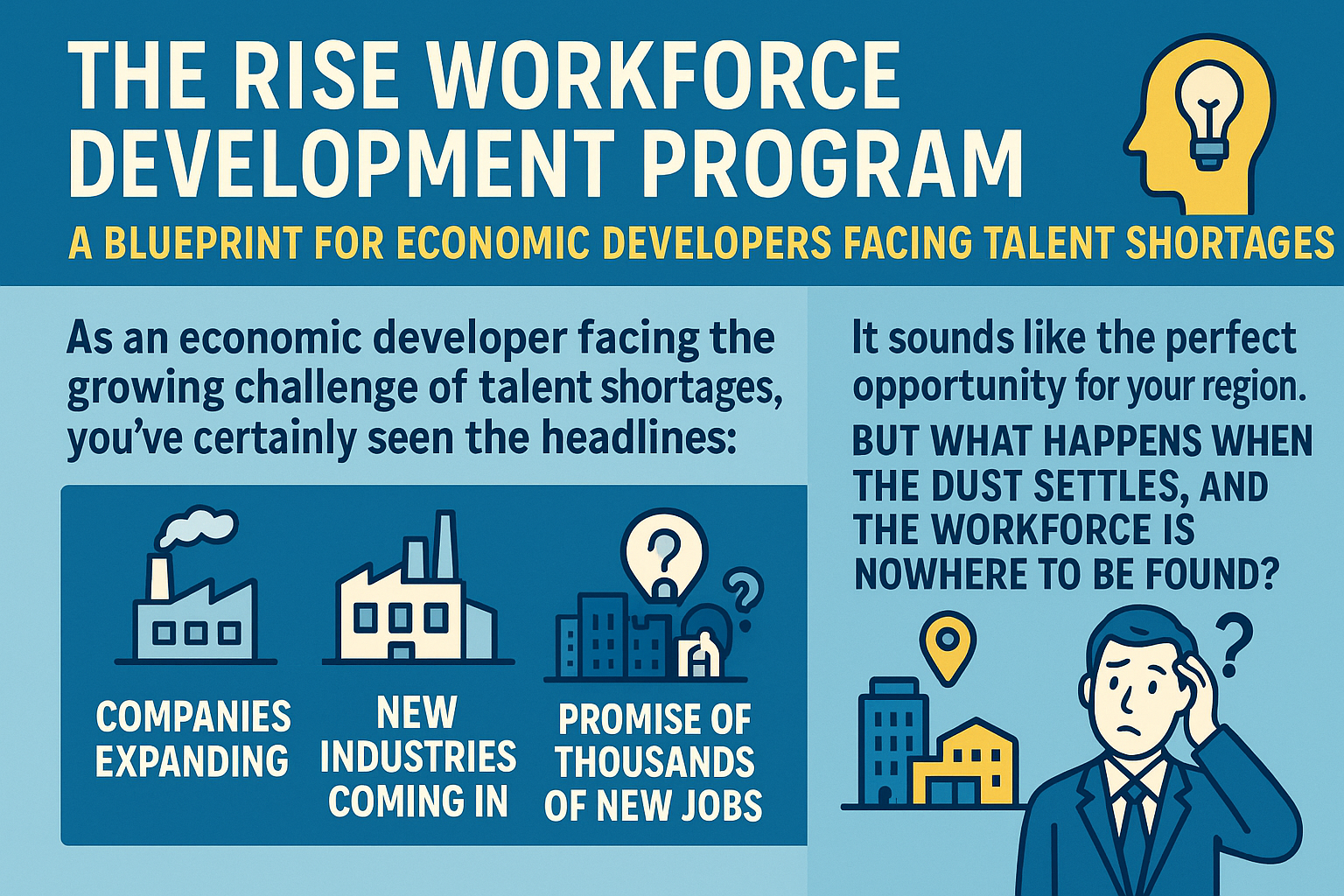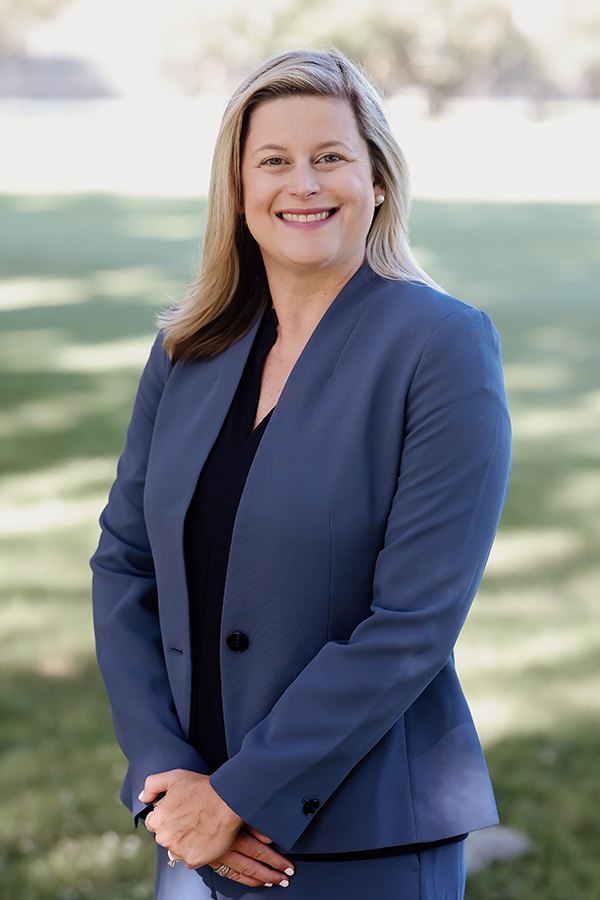A Blueprint for Economic Developers Facing Talent Shortages
The RISE Workforce Development Program:
A Blueprint for Economic Developers Facing Talent Shortages

As an economic developer facing the growing challenge of talent shortages, you’ve certainly seen the headlines: companies expanding, new industries coming in, and the promise of thousands of new jobs. It sounds like the perfect opportunity for your region. But what happens when the dust settles, and the workforce is nowhere to be found?
This is the reality many economic developers are facing, but one region has been rising to meet this challenge head-on: Savannah, Georgia. After Hyundai Motor Group announced the development of its $7.6 billion Metaplant America in Bryan County in 2022, the region faced a looming workforce crisis that many economic developers will recognize. The Savannah Harbor-Interstate 16 Corridor Joint Development Authority had successfully landed a major deal, and immediately they went to work to address the workforce challenge it created.

If you’re in a similar position, here’s a real-world example of how Savannah is responding to the challenge—and a road map of advice for tackling your own region’s talent shortage.
Anna Chafin was part of the four-county alliance that worked to attract Hyundai, serving as CEO of the Development Authority of Bryan County during that process. She is now the President and CEO of RISE, the Regional Industry Support Enterprise, tasked with coordinating workforce development and talent attraction to what is now an eight-county region surrounding Savannah.
In an interview with SEDC, Anna and Angela Hendrix, the Chief Marketing and Public Affairs Officer for the Savannah Economic Development Authority, describe the challenges faced and initiatives implemented to address the workforce needs of the region.
1. Understand the Full Scope of the Problem:
When Hyundai’s announcement hit the news, everyone celebrated. But then came the reality check. A commissioned workforce study quickly revealed that the Savannah region was facing a talent gap that would leave many industries struggling to fill positions. The region’s labor pool was stretched thin, exacerbated by the lingering effects of the COVID-19 pandemic. Predictions showed that by 2025, the workforce would be depleted if no action was taken, leaving even more holes in the labor market. In truth, the issue was not just about Hyundai—every business, from large corporations to small local shops, was feeling the pressure.
The lesson here is clear: Don’t wait for a crisis to emerge. Conduct workforce studies and assessments early in the process. Understand your labor pool and prepare for the long-term needs of both current and future industries. Identify the gaps in your region and start building solutions before the urgent need arises.
2. Take a Collaborative Approach:
The Savannah region’s response to the challenge was collaborative, and that’s a key takeaway for any economic developer. The Savannah Economic Development Authority (SEDA) launched the RISE (Regional Industry Support Enterprise) program in 2024, recognizing that solving workforce issues required the collective effort of not just one organization, but an entire region. RISE wasn’t about training individuals—it was about transforming the entire approach to workforce development.
At the heart of the initiative are Anna, Justin Farquhar, Vice President of RISE, and their talented team, including Maria Whitfield (Director of Employer Engagement) and Jennifer Collins (Program Manager). They united efforts across eight counties in the region, bringing together local development authorities, employers, and community stakeholders. This regional cooperation has been crucial to their success.
In order to shorten the learning curve for tackling a challenge of this scope, Anna is quick to acknowledge that they reached out to others who had faced similar challenges. She visited Meredith Rozanski in Bowling Green, Kentucky to learn about the SCK Launch program. It is a workforce development program developed and managed by the Bowling Green Chamber under Meredith’s leadership. A key feature of the program is Leader in Me.
For other regions struggling with workforce challenges, the message is clear: Don’t try to go at it alone. Involve local businesses, educational institutions, and community groups in the solution. A regional effort has more buying power and can create a more sustainable long-term strategy. And, as Anna emphasizes, do a study first to know the facts about your current workforce and what your challenges are.
3. Go Beyond Traditional Solutions:
As much as we love recruitment fairs and training programs, RISE quickly recognized that these traditional tools alone wouldn’t cut it. Instead, they dug deeper, identifying seven key pillars that either build or block a sustainable workforce. This holistic approach allows RISE to focus on creating a talent pipeline that is truly sustainable.
The seven pillars RISE identified are:
- Housing: Affordable Options Matter
Housing impacts workforce availability. As demand for housing rises and affordable options near job centers shrink, workers are forced to commute longer distances or decline job offers due to the high cost of living.
- Education: Connecting Classroom to Career
Aligning education with industry is key. It requires ongoing partnerships between schools, colleges, and businesses to ensure students see the real-world value of their education, and employers invest early in developing the future workforce.
- Childcare: The Barrier for Working Parents
Access to affordable, flexible childcare is crucial for working parents. In rural areas, limited childcare options and high costs prevent many parents from entering or staying in the workforce.
- Military: Supporting Seamless Transitions
With Fort Stewart and Hunter Army Airfield nearby, many transitioning military members are an untapped labor force. RISE is working to bridge the gap between military service and local employment, keeping this skilled talent in the region.
- Marketing: Reaching the Right People
Many career opportunities are under-advertised. RISE aims to create a regional brand to highlight local career paths, company cultures, and living opportunities, attracting both newcomers and locals seeking new jobs.
- Transportation: Making Commuting Accessible
Limited public transit and transportation options hinder access to jobs. RISE is exploring solutions like regional transit, carpool programs, and employer-sponsored shuttles to ensure commuting isn’t a barrier. - Underrepresented Individuals: Unlocking Untapped Potential
Barriers like language, criminal records, and systemic poverty prevent many from accessing economic opportunities. RISE is working to connect these individuals with employers and resources, turning potential into workforce strength.
This multi-faceted approach ensures that every aspect of workforce development is covered, not just recruitment and training. The key takeaway here is that workforce development is not a one-size-fits-all solution. It requires tailored strategies that take into account education, engagement, housing, transportation, and retention.
4. Create a Strategic Plan Rooted in Community Input:
Another strength of the RISE initiative has been its focus on community input. RISE wasn’t just a top-down project driven by government and industry leaders—it was built on the input of the very people who would be impacted by it. From local workers to business owners, RISE gathered insights from a wide range of stakeholders, ensuring that the program addressed real, on-the-ground needs.
For economic developers, this is a crucial step: Engage the community early. The workforce needs of tomorrow can’t be solved by a few people in a boardroom. Involve community leaders, educators, and workers to ensure your plan is comprehensive and effective. This will not only improve the outcome of your program but also build trust and buy-in from the community.
5. Invest in Long-Term Sustainability:
A key reason RISE has gained traction is that it’s not a short-term fix—it’s a long-term investment. With continued funding, a solid governance structure, and a focus on building sustainable talent pipelines, RISE is set to ensure that the Savannah region’s workforce challenges don’t derail the region’s growth in the years to come.
For economic developers, the message here is clear: Workforce development is a marathon, not a sprint. It requires sustained investment and strategic planning. Start by building a solid infrastructure, identifying key partners, and committing to the long-term development of your workforce.
Conclusion: RISE as a Model for Economic Development
RISE represents a bold, proactive approach to workforce development. It recognizes that successful economic development isn’t just about attracting new companies; it’s about ensuring that the local workforce is prepared, engaged, and capable of sustaining long-term growth. The Savannah region’s experience serves as a valuable case study for other regions facing similar workforce challenges.
As an economic developer, you can take inspiration from the Savannah region’s efforts:
- Conduct early workforce studies.
- Build a collaborative, regional strategy.
- Focus on comprehensive solutions.
- Engage the community.
- Commit to long-term sustainability.
Your region may not face a $7.6 billion plant, but you will face the same workforce challenges. With a proactive, comprehensive approach like RISE, your region can not only meet the challenge but thrive in the face of it.
